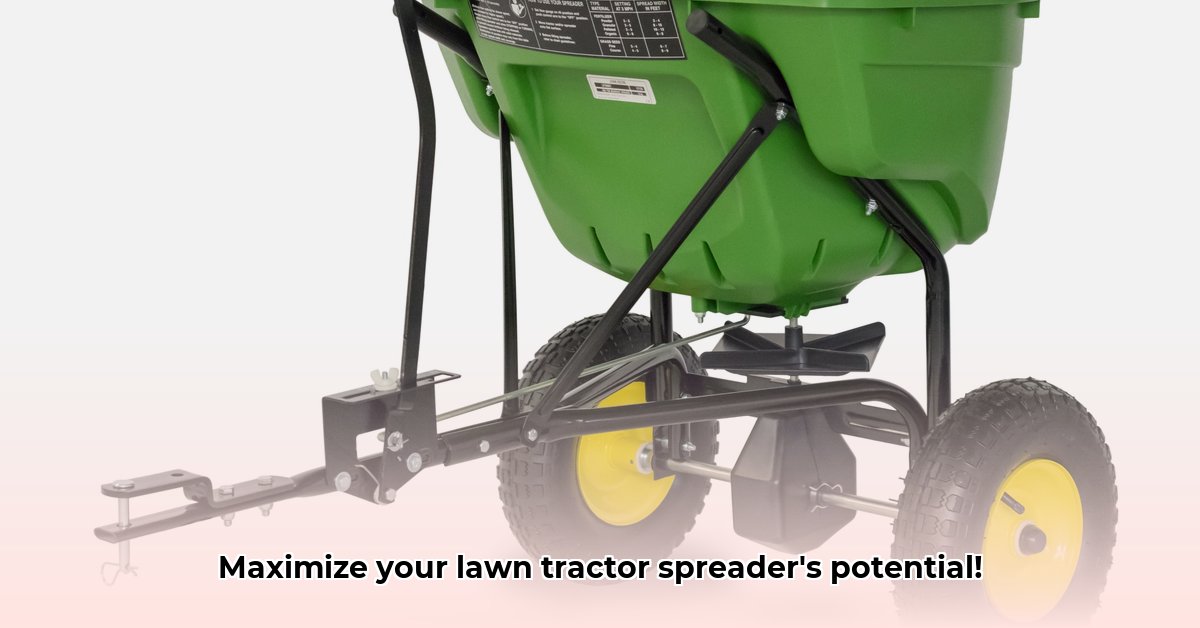
Choosing the Right John Deere Spreader: 130 lb vs. 175 lb
Selecting the optimal John Deere tow-behind spreader for your lawn tractor significantly impacts both efficiency and environmental sustainability. This guide focuses on the 130 lb and 175 lb models, helping you choose the best fit for your needs. The primary difference lies in their capacity: 130 lbs versus 175 lbs. But how does this translate to real-world application? For more spreader information, check out this helpful resource.
Capacity and Suitability: The 130 lb spreader is ideal for smaller lawns or smaller fertilization tasks. Think of it as your reliable tool for quick jobs—ideal for smaller properties. The 175 lb model, conversely, handles larger properties and substantial spreading tasks with greater efficiency. It's the larger capacity workhorse for covering more ground, allowing you to reduce the number of trips needed for refills. This translates into significant time and fuel savings.
Cost Considerations: While precise pricing information is unavailable here, it's safe to assume the 175 lb model carries a higher initial cost. However, the long-term cost savings from reduced labor and fuel consumption should be factored into the decision-making process. Weigh the initial investment against potential operational savings.
| Feature | 130 lb Spreader | 175 lb Spreader |
|---|---|---|
| Capacity | 130 lbs | 175 lbs |
| Approximate Coverage | Smaller lawns | Larger lawns |
| Spread Width | Up to approximately 12 feet | Information not readily available |
Data Limitations: Unfortunately, detailed specifications beyond capacity are currently unavailable. This lack of information emphasizes the importance of performing your own field tests to determine which spreader best suits your unique needs and lawn size.
Setting Up and Operating Your John Deere Spreader: A Step-by-Step Guide
Efficient spreader use begins with proper setup and calibration. Follow these steps for optimal performance:
1. Assembly: Carefully unpack your spreader and refer to the manufacturer's instructions for detailed assembly guidance.
2. Calibration: Proper calibration is essential for accurate fertilizer application. This involves determining how much material the spreader dispenses over a known area. Use a measurement method to determine your spreader's output, then fine-tune its settings (often levers or dials) to dispense the correct amount for your target area. Many online resources detail how to perform this calibration process effectively.
3. Adjusting the Spread Width: Your spreader allows for adjustable spread width. A wider spread reduces the number of passes required, but excessively wide settings can lead to uneven distribution. Experiment to find the ideal setting for your specific lawn and spreader.
4. Setting the Application Rate: This refers to the amount of material dispensed per unit area. The spreader should have controls to adjust this rate. Manufacturer recommendations often serve as a starting point, and adjustments may be necessary.
5. Safe Operation: Prioritize safety! Always wear appropriate protective gear, including gloves and eye protection. Follow all safety guidelines detailed in your owner's manual. Operating a tow-behind spreader safely requires attention and attentiveness to all surrounding conditions.
Achieving Uniform Application: Optimizing Fertilizer Distribution
Even fertilizer distribution is crucial for healthy lawn growth and minimizes fertilizer waste. Uneven spreading leads to patchy growth and inefficiencies. Here’s how to achieve uniform application:
Consistent Driving Speed: Maintain a steady speed throughout the application process. Variations in speed directly impact the rate of distribution.
Overlapping Passes: Overlap adjacent passes by roughly 50%. This eliminates skips and guarantees complete coverage, much like painting a fence—you don't leave gaps!
Navigating Uneven Terrain: Uneven terrain necessitates adjustments to speed and application rates. Multiple passes on slopes may be needed.
Independent Field Testing: While John Deere promotes even coverage, conducting independent field testing is highly recommended. Mark test areas and measure fertilizer density to identify any inconsistencies.
Minimizing Environmental Impact: Sustainable Lawn Care Practices
Sustainable lawn care prioritizes minimizing fertilizer runoff, which can pollute water sources. Here's how to reduce your environmental impact:
Best Management Practices (BMPs): Familiarize yourself with your local BMPs for fertilizer application. These best practices often incorporate the best guidelines for reducing negative environmental impact and ensure responsible fertilizer use.
Local Regulations: Adhere to all local and regional regulations concerning fertilizer application and its appropriate use. Understanding these guidelines is crucial.
Alternative Fertilization: Explore alternatives such as compost or organic fertilizers to reduce reliance on synthetic products, reducing your overall environmental impact. The use of such alternatives has been shown to be a major method to promote more sustainable practices.
Maintenance and Troubleshooting: Ensuring Long-Term Performance
Regular maintenance extends the lifespan of your spreader and ensures optimal operation.
Cleaning: Clean the spreader thoroughly after each use to prevent material buildup and corrosion. A clean spreader is a well-maintained spreader.
Inspection: Regularly inspect for wear and tear. Early detection of potential problems prevents costly repairs.
Lubrication: Lubricate moving parts according to the owner's manual for smooth and efficient operation.
Conclusion: Towards a Healthier, Greener Lawn
Choosing and using the correct spreader is vital for efficient and sustainable lawn care. While this guide provides a foundation, remember that your specific lawn conditions may necessitate continued research and experimentation. Sustainable practices are an ongoing process, so keep learning and adapting your approach for a healthier and greener lawn.